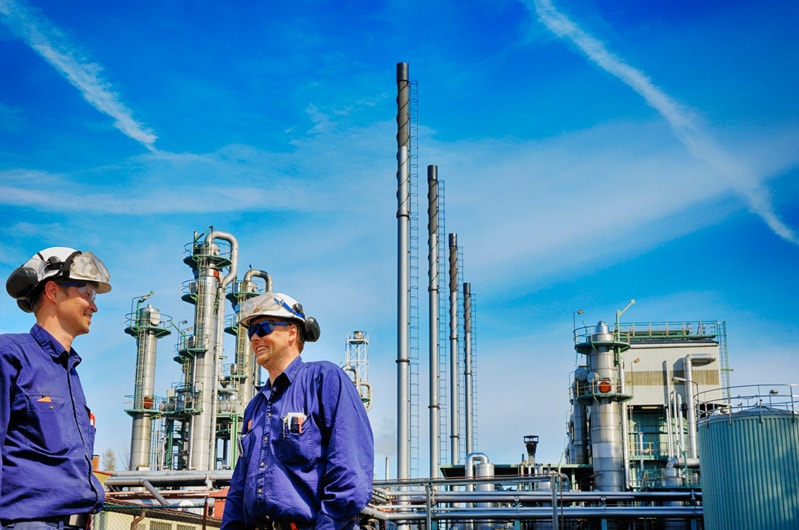Exploration and drilling
When 3D seismic investigation has been completed, it is time to drill the well.
Normally, dedicated drilling rigs either on mobile onshore units or offshore
floating rigs are used. Larger production platforms may also have their own
production drilling equipment.
The main components of the
drilling rig are the derrick, floor,
drawworks, drive and mud
handling. Control and power can
be hydraulic or electric.
Earlier pictures of drillers and
roughnecks working with rotary
tables (bottom drives) are now
replaced with top drive and semiautomated pipe handling on larger
installations. The hydraulic or
electric top drive hangs from the derrick crown and gives pressure and
rotational torque to the drill string.
The whole assembly is controlled by the
drawworks. Photo: Puna Geothermal Venture
The drill string is assembled
from pipe segments about 30
meters (100 feet) long, normally
with conical inside threads at
one end and outside at the
other. As each 30 meter
segment is drilled, the drive is
disconnected and a new pipe
segment inserted in the string. A
cone bit is used to dig into the
rock. Different cones are used
for different types of rock and at
different stages of the well. The
picture above shows roller cones with inserts (on the left). Other bits are
PDC (polycrystalline diamond compact, on the right) and diamond
impregnated. Photo: Kingdream PLC
27
As the well is sunk into the ground, the weight of the drill string increases
and might reach 500 metric tons or more for a 3,000 meter deep well. The
drawwork and top drive must be precisely controlled so as not to overload
and break the drill string or the cone. Typical values are 50kN force on the
bit and a torque of 1-1.5 kNm at 40-80 RPM for an 8-inch cone. Rate of
penetration (ROP) is very dependent on depth and could be as much as
20m per hour for shallow sandstone and dolomite (chalk), and as low as 1m
per hour on deep shale rock and granite.
Directional drilling is
intentional deviation of a
well bore from the vertical.
It is often necessary to drill
at an angle from the
vertical to reach different
parts of the formation.
Controlled directional
drilling makes it possible to
reach subsurface areas
laterally remote from the
point where the bit enters
the earth. It often involves
the use of a drill motor
driven by mud pressure mounted directly on the cone (mud motor, turbo drill,
and dyna-drill), whipstocks – a steel casing that bends between the drill pipe
and cone, or other deflecting rods, also used for horizontal wells and multiple
completions, where one well may split into several bores. A well that has
sections of more than 80 degrees from the vertical is called a horizontal well.
Modern wells are drilled with large horizontal offsets to reach different parts
of the structure and achieve higher production. The world record is more
than 15 km. Multiple completions allow production from several locations.
Wells can be of any depth from near the surface to a depth of more than
6,000 meters. Oil and gas are typically formed at 3,000-4,000 meters depth,
but part of the overlying rock may have since eroded away. The pressure
and temperature generally increase with increasing depth, so that deep wells
can have more than 200 ºC temperature and 90 MPa pressure (900 times
atmospheric pressure), equivalent to the hydrostatic pressure set by the
distance to the surface. The weight of the oil in the production string reduces
wellhead pressure. Crude oil has a specific weight of 790 to 970 kg per cubic
meter. For a 3,000 meter deep well with 30 MPa downhole pressure and
normal crude oil at 850 kg/m3
, the wellhead static pressure will only be
28
around 4.5 MPa. During production, the pressure will drop further due to
resistance to flow in the reservoir and well.
The mud enters though the drill pipe, passes through the cone and rises in
the uncompleted well. Mud serves several purposes:
• It brings rock shales (fragments of rock) up to the surface
• It cleans and cools the cone
• It lubricates the drill pipe string and cone
• Fibrous particles attach to the well surface to bind solids
• Mud weight should balance the downhole pressure to avoid leakage
of gas and oil. Often,
the well will drill though smaller pockets of
hydrocarbons, which may cause a “blow-out" if the mud weight
cannot balance the pressure. The same might happen when drilling
into the main reservoir.
To prevent an uncontrolled blow-out, a subsurface safety valve is often
installed. This valve has enough closing force to seal off the well and cut the
drill string in an uncontrollable blow-out situation. However, unless casing is
already also in place, hydrocarbons may also leave though other cracks
inside the well and rise to the surface through porous or cracked rock. In
addition to fire and pollution hazards, dissolved gas in seawater rising under
a floating structure significantly reduces buoyancy.
The mud mix is a
special brew designed
to match the desired
flow thickness,
lubrication properties
and specific gravity.
Mud is a common name
used for all kinds of
fluids used in drilling
completion and
workover and can be
oil-based, water-based
or synthetic, and
consists of powdered
clays such as bentonite, oil, water and various additives and chemicals such
as caustic soda,
barite (sulfurous mineral), lignite (brown coal), polymers and
emulsifiers. Photo: OSHA.gov
A special high-density mud called “kill fluid” is used to shut down a well for
workover.
29
Mud is recirculated. Coarse rock shales are separated in a shale shaker
before it is passed though finer filters and recalibrated with new additives
before returning to the mud holding tanks.


